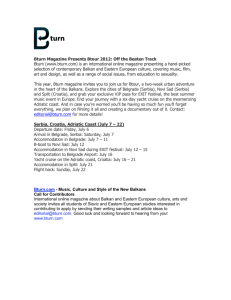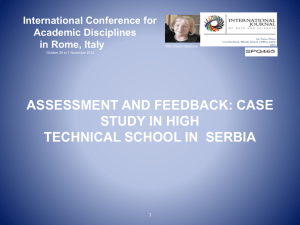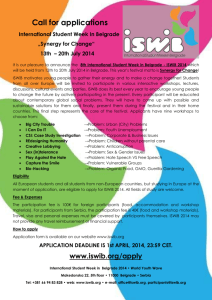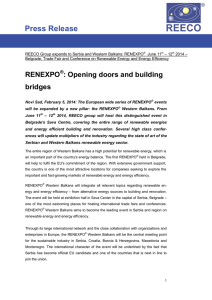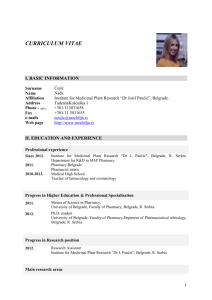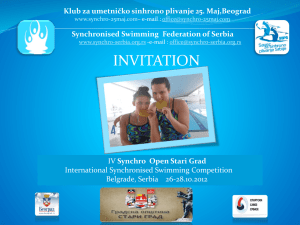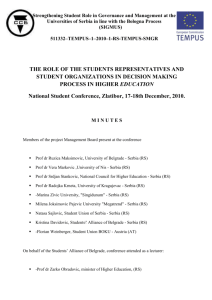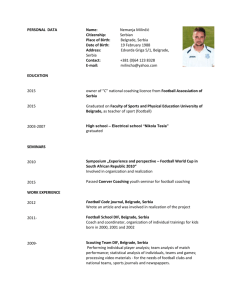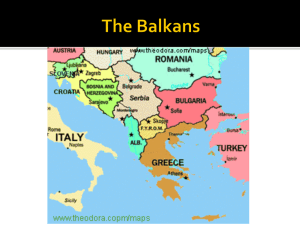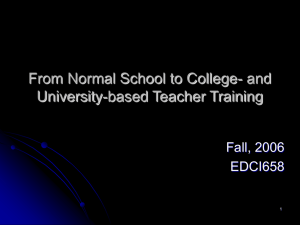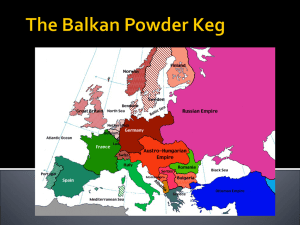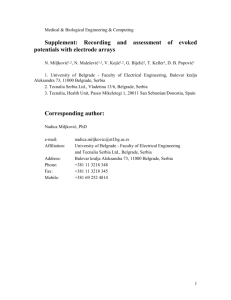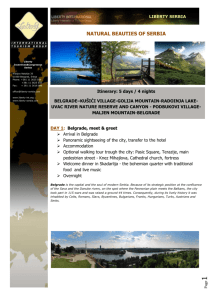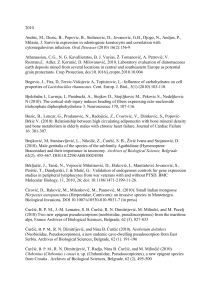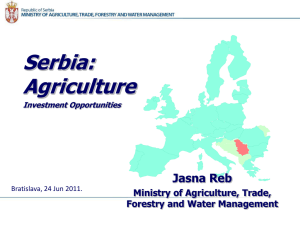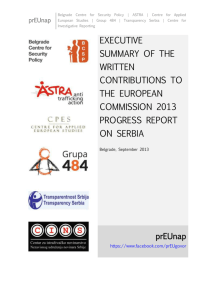and accreditation Schools of Applied Studies in Serbia
advertisement
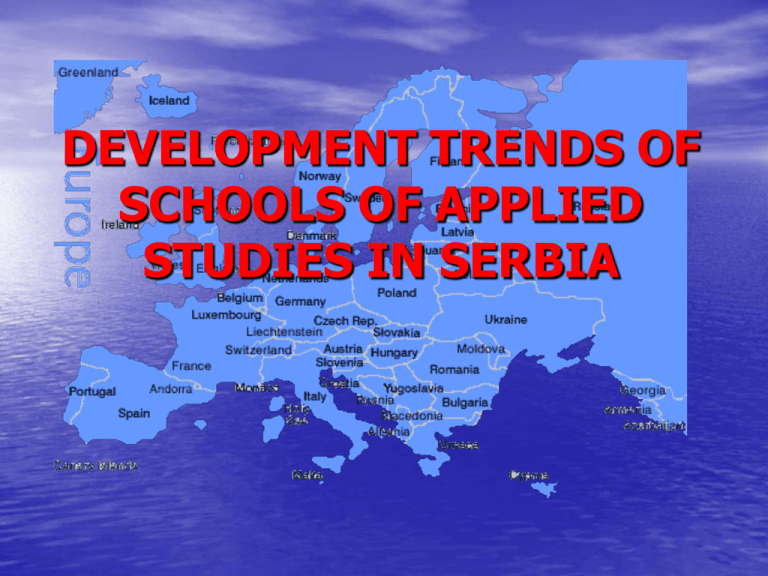
DEVELOPMENT TRENDS OF SCHOOLS OF APPLIED STUDIES IN SERBIA IMORTANT FACTS ABOUT HIGHER EDUCATION INSTITUTIONS OF APPLIED STUDIES IN SERBIA Long tradition The place and role in the educational system Number of students Resources Orientation towards professional practice Close cooperation with the economy Market demands The first fact which is imposed is that this level of education represents a necessary sector in the education of the population. Long tradition of colleges in Serbia Domestic and trade colleges were established before World War II. The oldest postwar college was founded in 1952 in Novi Sad. During the 50s, the greatest number of colleges of that time were teacher training colleges where teaching staff for elementary schools was educated. Long tradition of colleges in Serbia In the late 50s of the 20th century, a number of higher schools was established: Commercial College in Belgrade (1956) Railway College in Belgrade (1957) Textile College in Belgrade (1958) Teacher training College in Priština (1958) Polytechnic College in Belgrade (1959) Polytechnic College in Novi Sad (1959) Technical-mechanical College in Zemun (1959) A number of transformations occurred in the development of colleges, not only in the curriculums but also in the organizational aspects. “The Bologna process” and accreditation in 2002, some colleges introduces ‘the Bologna process’ as its recognizable way of thinking and norm of behaviour. Law on higher education came into effect in 2005 and with it the process of accreditation of colleges began first. Owing to its adaptability, all 47 state colleges managed to go through the rigorous process of accreditation and became Schools of Applied Studies. 18 private higher schools were also accredited. Schools of Applied Studies in Serbia State Private 47 18 Technical Economics Other 15% 24% 8% Property structure 65 47+18 18 47 State Private Educational structure of the total number of Serbian population older than 15 (According to the data of the Republic Bureau for Statistics) 4 15,9 Faculty or academy 9 College or School of Applied Studies Secondary school Elementary school 22,6 48,5 No elementary school completed or elementary school not fully completed Increased interest in professionallyoriented higher education 10,0% 9,0% 8,0% 7,0% 6,0% 5,0% 4,0% 3,0% 9,0% 6,5% 4,5% 4,0% 2,0% 1,0% 0,0% 2002 2008 Academic studies Applied studies The sector for higher applied education, as the highest level of professional education, depends on a relatively numerous basis of students with applied secondary school education (80.1% of total number of secondary school students). 68114 Secondary school students in vocational secondary school education Grammar school students 285596 Annual admission quota (Admission quota for the sector for applied studies is 41% of the total annual student admission quota) 32500 Sector for applied studies Sector for academic studies 22500 25931 Sector for applied studies Sector for academic studies Number of graduated students in 2008 (36.1% students graduated in the sector for applied studies) 14399 Students with professionally-oriented higher education 60-70% 30% 20% 10-15% European average Austria Serbia Holland Assessment of needs for high-qualified staff in Europe until 2020 60 50 47.8 49.5 49.9 Medium qualification, ISCED 3-4 High qualification, ISCED 5-6 40 30 27.7 31.1 23.4 20 10 0 2000 2010 2020 IMPORTANT FACTS Close cooperation and connection with the economy for which skilled and professional staff is educated. The practical part of the dual system of education is realized in economic subjects through practical teaching and professional practice. The relation between academic and practicallyoriented work in Schools of Applied Studies Practicallyoriented work Academic work 40% Strategic directions Strategic directions for the development of professional education in applied studies are: providing the quality of applied education, development of the standard system, further advances in study plans and programs, creating conditions for continuous professional training of teachers, providing better vertical and horizontal mobility of students, Strategic directions new connection of education and the labour market, satisfying increased economy demands, increased financial investment and involving different sources for financing, providing conditions for acquiring the certificate and diploma systems, rationalization and coordination of networks of schools of applied studies with the needs. INTERNATIONAL COOPERATION Coordination of study plans and programs; Teaching staff exchange; Student exchange; Participation in joint projects. EXAMPLE OF INTERNATIONAL COOPERATION OF SCHOOLS OF APPLIED STUDIES In November, a group of 19 students from University of Applied Studies DHBW in Stuttgart – Germany, will attend classes at schools of applied studies in Serbia – in Blace, Valjevo and Belgrade, and they are going to visit domestic companies and learn about professional practice there. In december 2011, the 10th generation of our students will attend classes for one module at the University of Applied Studies DHBW in Stuttgart. AN IMPORTANT FACT IS ALSO: That with the help of the Ministry for education and science, National Council for higher education, National council for science and technological development, as well as the Board for accreditation and quality assurance, all schools of applied studies in Serbia introduced and implemented the quality system. An increasing number of teachers at schools for applied studies is engaged in scientific research although only research is required according to the Law. We hope that the changes in the Law will require this sector to do scientific research and in this way enable participation in new projects of general importance. CONCLUSION Besides the conclusions which directly arise from the previously presented important facts, the aims of schools of applied studies are: Improving the quality of teaching and cooperation with economy, Introducing long-distance educational system, Formation of academic applied studies for more efficient functioning and organizing, Introducing master applied studies which would enable the citizens of Serbia to receive that type of binary-dual educational system, which is significantly reviewed and confirmed in Europe. THANK YOU FOR YOUR ATTENTION! Ružica Stanković, PhD Branislav Jevtović, PhD Borivoje Rodić, PhD Dragoljub Martinović, PhD Miroljub Milivojčević, PhD Tanslated by Ivana Đokić Belgrade, September 2011 konferencija@vpskp.edu.rs
